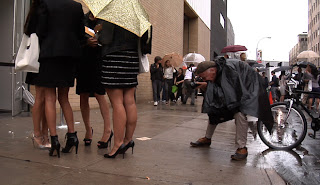The film begins with Brandon, naked in bed. We see him laying with the sheet up to his navel, staring off into space, music swells the screen. He refuses to look at us, or even in our general direction. Brandon is not someone that McQueen is going to let us get close to. Brandon's apartment is a square, white space. We walk the entire length of the apartment with Brandon; from bedroom, to living room, to bathroom, fully nude, somewhat at peace, uninhibited in this sterile place. Brandon's world is constructed out of clean lines, there are no distractions here, nothing to excite the senses, this is a world in which Brandon's addiction can be released. Brandon is an addict, a slave to his body, perpetually fixed on getting off. McQueen never illuminates the cause or circumstances that lead Brandon to this place of alienation, of self-abuse, but we are allowed to see his deterioration, mostly without judgement because we are left out of his past. Brandon's daily routine is infallible; masturbate at home, watch porn at the office, masturbate in the bathroom at work, call a prostitute when he gets home, or watch porn till he falls asleep. Sex propels his day, he is bound by his innate and often unexplained urges.
His world, and the viewers, is turned upside down when Brandon's sister Sissy shows up unexpectedly in Brandon's apartment. Sissy is the alter ego of Brandon; chaotic, impulsive, overly emotional. McQueen counterbalances Brandon's world through Sissy. She is also pained, chained to her sensitivity, a similar victim of circumstance. They have several exchanges throughout the film, which I believe make this movie nothing short of special. Their interactions are heated, filled with confusion, anger, resentment, and an intense need for emotional connections. This pair of actors are the reason this fim exceeds beyond a simple exploitative film about the cage of sexual addiction and depression. Without Brandon and Sissy, this film is just porn, just a meditation on the breaking of flesh for carnage and self abusive needs. But with them, it surpasses the need for pleasure and breaks into a world of pain. The sex in this film is obtrusive, violent, at times the viewer feels the needs to look away from the screen, but through Sissy and Brandon the sex transcends the physical to become a representation of pain and suffering. These characters are locked in its embrace and are slowly churned into oblivion.
Fassbinder is fearless and naked (physically but more importantly emotionally) in this performance, allowing himself to be the instrument for his director's art. He brings Brandon's story to life and although we may not understand why he is the way he is or sympathize with his affliction, we care till the very end. Mulligan takes no prisoners in this film, she is uncompromising and doesn't ever plead the audience for their sympathy, though she may require it from Brandon. The siblings relationship is the heart of this film and honestly I wish McQueen could have found more areas to explore with them. The only fault of this film was it's insistence on pushing the envelope with it's NC-17 rating, giving the audience more flesh than we required and leaving us a bit high and drive on the emotional connections, but Shame doesn't ask more from it's audience than to open our eyes and drink in what we see.
Brandon and Sissy before a moment of explosion.
Brandon in his devoid white world.
A victim of his fate.
Brandon's most intimate interaction that fizzles into impotence.
Brandon, in his empty space, watching porn.
Sissy's heartbreaking performance of "New York, New York".
The pain is palpable. Mulligan is astonishing.





































